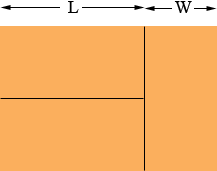| |||
| Math Central | Quandaries & Queries |
|
Question from Meagan, a student: Here is my problem: Three congruent (non-square) rectangles are placed |
Hi Meagan,
I called the lengths of the triangles L centimeters, the widths W centimeters and put them together the way you described.

From the diagram the area is (L + W) × (2W) which is 1350 square centimeters. Look at the diagram, what relationship can you see between L and W? Substitute this into the area relationship above and solve for L and W.
Can you see now how to complete the solution?
Penny
 |
||
Math Central is supported by the University of Regina and The Pacific Institute for the Mathematical Sciences.